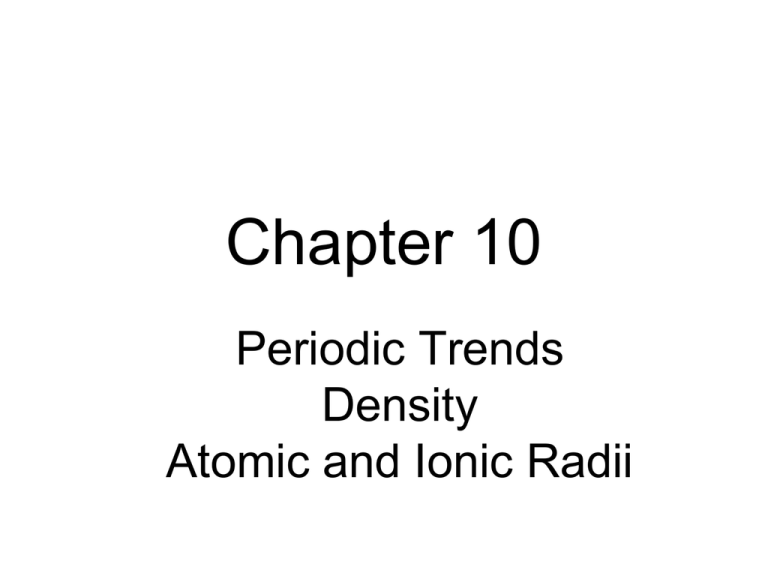Density
advertisement

Chapter 10 Periodic Trends Density Atomic and Ionic Radii Density Density • Iridium (Z = 77) has the highest density. • Why not Meitnerium (Z = 109?) • We can predict that an element is more dense if it is closer to Iridium. Density Effective Nuclear Charge (Zeff) • The effective nuclear charge (Zeff) of an atom is basically how well it is able to hold on to its most loosely held electron. Atomic radius (radii) • The atomic radius is essentially the size of an atom. • The largest atom is Francium (Z = 87). Atomic Radius Xylophone monkey Rank the atoms from smallest to largest Na, K, O, N O < N < Na < K Atomic Radius and Effective Nuclear Charge • The atomic radius decreases as effective nuclear charge increases. Effective Nuclear Charge (Zeff) • The effective nuclear charge of an atom is primarily determined by: 1. The nuclear charge 2. The shielding effect The Nuclear Charge (Z) • Based on the number of protons in the nucleus. – Example: Carbon vs. Nitrogen The Nuclear Charge (Z) Carbon Nitrogen The Nuclear Charge (Z) • The greater the number of protons in the nucleus the greater the effective nuclear charge. Carbon Nitrogen Conclusion: Nitrogen is a smaller atom than carbon because nitrogen has 7 protons to pull in its electrons whereas carbon only has 6. Carbon Nitrogen Nuclear charge explains why atoms get smaller across a period Atomic Radius Xylophone monkey Shielding Effect. • The shielding effect is when electrons between the nucleus and the outermost electrons in an atom shield or lessen the hold of the nucleus on the outermost electrons. Shielding Effect. He Ne Conclusion: Neon is larger than helium because it has an increased shielding effect from having two energy levels whereas helium only has one energy level. He Ne Shielding Effect explains why atoms get larger down a group Atomic Radius Xylophone monkey Chemical Reactivity Chemical Reactivity Chemical Reactivity • Metals tend to lose electrons when reacting. – Large metal atoms are more reactive. • Nonmetals tend to gain electrons when reacting. – Small nonmetal atoms are more reactive. Chemical Reactivity • Metals increase in reactivity left and down. • Nonmetals become more reactive up and to the right. • Most reactive metal is? Fr • Most reactive nonmetal is? F Ionic Radius • Ionic Radius is the size of an ion. Size Change in Ion Formation Rules for Ionic Radius • Anions (negative ions) are “always” larger than cations (positive ions). • Ionic Radius goes by the same rules as atomic radius (ions get larger as we move down and to the left). • However it is necessary to treat anions and cations separately. (Anions are bigger). Rank the ions from smallest to largest K+, N3-, Na+, O2- + Na + <K < 2O < 3N Homework • Worksheet: Density, Atomic and Ionic Radii











